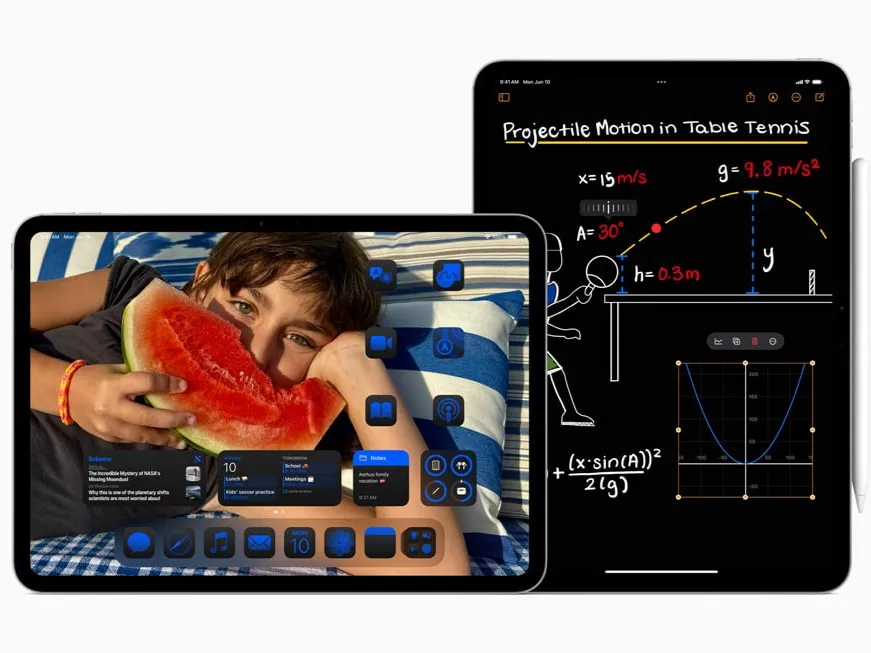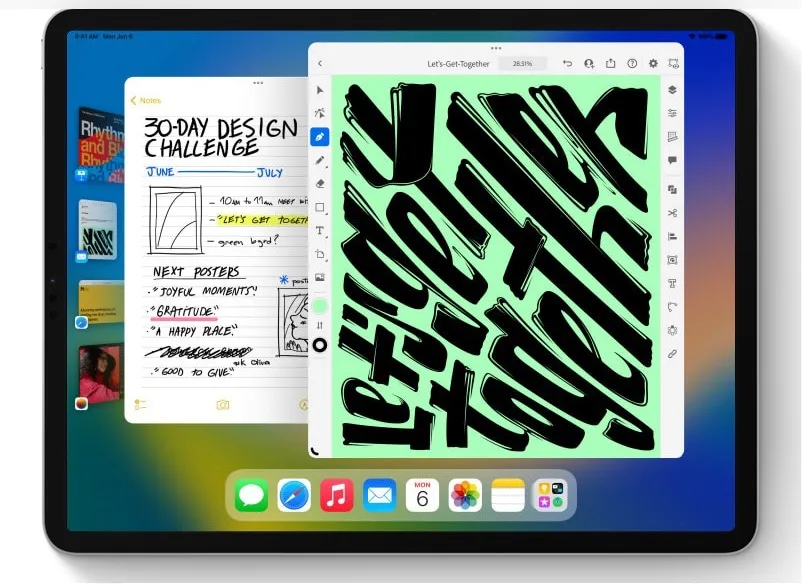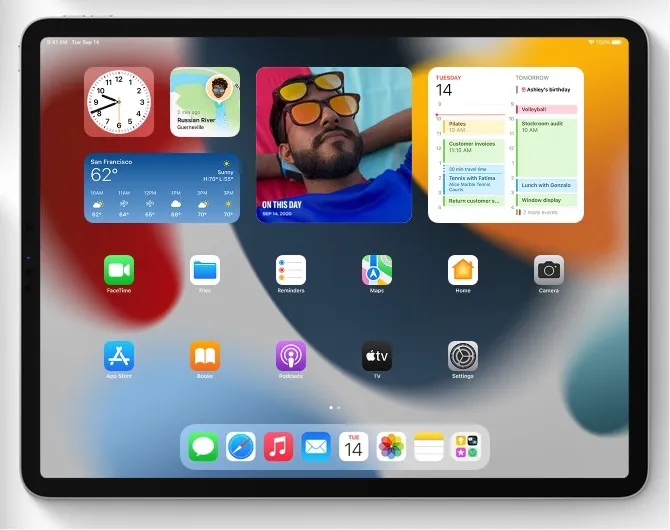A Complete List of iPadOS Operating Systems
Apple continues to develop new generations of iPads with an operating system that also keeps evolving. It began with iPhoneOS, then became iOS (from iOS 4 to iOS 12), just like the iPhone.
At WWDC (Worldwide Developers Conference) 2019, Apple announced that the iPad would use a system developed separately from iOS. This system is called iPadOS. The change was made so the iPad could have its own navigation and features to make it more optimized compared to iOS.
So, how has iPadOS grown over time? Let’s take a look at the list of versions, starting from the newest to the earliest, beginning with iPadOS 13. Starting with the latest version helps readers get the most up-to-date and relevant information first.
1. iPadOS 26

At WWDC 2025, Apple introduced iPadOS 26 along with iOS 26. The number 26 represents its wider use in 2026. That is why the system jumped from iPadOS 18 to iPadOS 26.
iPadOS 26 is not just a yearly update. It brings major changes in how people use the iPad, with several groundbreaking features.
- HoloDesk
The key highlight is “HoloDesk.” This feature lets you project the iPad interface onto any flat surface, such as a desk. The projection is interactive as it can turn the desk into a second screen.
For example, while editing videos in Final Cut Pro, you can move the timeline and tools to the table and interact with them directly by touch. It feels like working with real objects.
This is possible because of the new iPad Pro, which combines a LiDAR system with an advanced projector. HoloDesk will greatly help creative professionals who need more space and flexibility in their work.
- Apple Pencil
In iPadOS 26, the Apple Pencil becomes more than just a stylus. Two new features make it even more powerful: Spatial Input and Haptic Canvas.
- Spatial Input
Apple now lets the Pencil interact with 3D objects and Augmented Reality (AR). For example, an architect can “lift” a building model from the iPad screen, place it on the desk in AR, then rotate or scale it with the Pencil.
- Haptic Canvas
This gives precise vibrations that simulate real textures when drawing or painting. Using an oil brush in Procreate feels rough like a real canvas. Switching to a graphite pencil gives a smooth, paper-like feel.
Together, these features give artists and designers a more realistic and satisfying creative experience. The new Apple Pencil Pro is now a must-have tool for professionals.
- Apple Cognition: Smarter AI
After Apple Intelligence, Apple introduced its smarter successor: Apple Cognition. Unlike older AI that only reacted to commands, Apple Cognition anticipates the user’s needs.
It runs on iPads with R-series chips or newer, moving beyond the M-series. Apple Cognition learns your workflow. For example, if you often prepare weekly sales reports using Numbers and Keynote, the system will notice this pattern.
The following week, it can suggest creating a draft report automatically, complete with charts and visuals. A simple voice command like, “Create this week’s sales report,” will generate the draft instantly.
- Shared Space
The old Remote Control feature has now evolved into Shared Space. This is a real-time collaborative canvas that works across the system.
From the Freeform app, you can start a Shared Space session and invite colleagues anywhere in the world. You can draw with Apple Pencil, while others add notes or drop in files directly. This makes teamwork faster and smoother compared to video calls and screen sharing.
- Continuity Sphere
Support for external devices in iPadOS 26 reaches its peak with Continuity Sphere. With this feature, Apple devices around you connect automatically without needing manual setup. The iPad can detect and integrate them on its own.
One clear example is live streaming. You can place your iPhone across the room to get a different camera angle, and iPadOS 26 will instantly recognize it as a wireless external camera.
Switching between the iPad and iPhone cameras only takes a single tap on the app. The same applies to other devices, such as the microphone on the HomePod or the trackpad on the MacBook. This makes the Apple ecosystem smoother and more connected than ever, and it is very difficult for other operating systems to match.
iPadOS 26 feels like more than just a yearly update. It introduces features that show how technology should truly work. With innovations like HoloDesk, Apple Pencil with Spatial Input, and Apple Cognition’s proactive intelligence, iPadOS 26 strengthens the iPad’s role as a main device for creators, professionals, and anyone who wants to bring ideas to life.
Supported Devices for iPadOS 26
- iPad Pro (models with M7 chip or newer)
- iPad Air (models with M9 chip or newer)
- iPad (14th generation or newer)
- iPad mini (10th generation or newer)
2. iPadOS 18

At WWDC 2024, Apple introduced iPadOS 18. In the event, Apple explained that this version brings new features that can change the way users work and create. Compared to the previous version, iPadOS 18 offers many more interesting improvements.
- Calculator with Math Notes
For a long time, people joked that the iPad had no built-in calculator. Many users relied on third-party apps instead. With iPadOS 18, Apple finally introduced a calculator app, but not in the usual way.
The calculator is combined with Math Notes, a feature that lets you do calculations directly from handwritten notes. For example, if you write down “400 x 20 x 7,654” with the Apple Pencil, the calculator will read your handwriting and instantly give the result. This makes calculations faster and easier.
- Improved Apple Pencil Support
In iPadOS 18, the Apple Pencil becomes more powerful. The new Smart Script feature lets users write in any text field, and handwriting is instantly converted into typed text.
The Apple Pencil also makes notes more interactive. AI in Notes can recognize rough shapes and turn them into neat objects. For example, if you draw an airplane but the sketch is not clear, Notes will correct it into a precise figure.
There is also a feature that allows you to select and edit handwritten text more easily. These updates will encourage more people to use the Apple Pencil, even though it is not a cheap accessory.
- Apple Intelligence
Apple’s AI, called Apple Intelligence, is also present in iPadOS 18, just like in iOS 18. This feature is available only on iPads with an M1 chip or newer. Devices that still use A-series chips do not get it, at least for now.
Apple Intelligence enhances creative apps. In Notes, it recognizes shapes and improves sketches. In Procreate X, features like Auto-Brush and Color-Suggestion provide style and color recommendations that fit your project.
- Home Screen Personalization
iPadOS 18 lets you customize the Home Screen more freely. You can add interactive widgets from different apps, resize app icons, and rearrange layouts to match your style.
- Notes App Improvements
The Notes app introduces helpful new tools. The Highlight feature lets you mark text with colors, while Collapsible Sections help you organize long notes into smaller, easier parts.
- Remote Control feature
Another new feature is Remote Control, which allows you to control another iPad remotely with permission. This is useful if you want to help a family member or friend fix a problem. Instead of explaining through video calls or messages, you can now control their iPad directly.
- Support for External Devices
iPadOS 18 also improves support for external devices such as cameras, microphones, and storage drives. Connecting them is simple, making it easier to record videos, take photos, or transfer files. This feature is especially useful for creators who make content or stream live on social media.
Overall, iPadOS 18 is a big update that brings many valuable features. With tools like Calculator with Math Notes, improved Apple Pencil support, and Apple Intelligence, this version helps users be more productive and creative.
Supported Devices for iPadOS 26
- iPad mini (5th generation and later)
- iPad Pro (all models)
- iPad Air (3rd generation and later)
- iPad (6th generation and newer)
3. iPadOS 17

iPadOS 17 introduces many new features that make the iPad experience more personal and productive. One of the biggest changes is the lock screen, which is now more customizable. Users can set wallpapers, add interactive widgets, and choose different font styles to match their preferences.
Interactive widgets make tasks faster with just one tap. They also provide quick access to important information, which is very practical for daily use.
The Messages app also received important updates. Stickers are now more expressive, and the search function in conversations has become more intuitive, so it's easier to find old messages. FaceTime is more fun too, thanks to new interactive reactions that add energy to video calls.
Another highlight is the arrival of the Health app on iPad, which was previously only on iPhone. The larger iPad screen allows users to view health data in more detail, making it very useful for anyone who wants to track their health seriously.
For those who often work with PDF documents, iPadOS 17 makes things much easier. Users can add notes, highlight text, and fill out forms directly in the app. This is especially helpful for work or school tasks.
Other improvements include updates to the Reachability feature and the Keyboard. Screen Distance is now easier to use and offers more options. The Keyboard has smarter text prediction and supports more languages, making typing in different languages more convenient.
Key Features of iPadOS 17
- Personalized Lock Screen: Custom wallpapers, widgets, and font styles.
- Interactive Widgets: Faster access to tasks and information.
- Messages Improvements: More expressive stickers and better search.
- FaceTime Reactions: Fun interactive effects for video calls.
- Health App on iPad: View detailed health data on the larger screen.
- PDF Editing: Add notes, highlights, and fill forms easily.
- Reachability and Keyboard Updates: Easier customization and better language support.
Supported Devices for iPadOS 17
- iPad Pro: 12.9-inch (2nd generation and newer), 11-inch (1st generation and newer), 10.5-inch
- iPad Air: 3rd generation and newer
- iPad: 6th generation and newer
- iPad mini: 5th generation and newer
4. iPadOS 16

At WWDC on June 6, 2022, Apple introduced iPadOS 16 together with iOS 16 and the MacBook Air M2. This update brought important new features such as faster multitasking, more laptop-style apps, and better security including improvements in the Safari browser.
Not all iPads can use iPadOS 16. Only newer models are supported. Older devices such as the iPad Air 2 (2014) and iPad mini 4 (2015) do not receive the update.
One of the main highlights of iPadOS 16 is Stage Manager. This feature makes multitasking on the iPad feel closer to using a MacBook. It allows apps to open in resizable windows, not just in full screen or split screen. With this, users can run several apps at the same time more smoothly and efficiently.
Apple also improved Notes and Pages. These apps are now more collaborative, similar to Google Docs. You can tag people, let them edit notes, and access documents from different devices. They support Apple Pencil and can handle files like PDFs, images, and web links.
Another new app, Freeform, was introduced for teamwork. It lets users share files, take notes together, and build presentations on a shared canvas.
For gaming, iPadOS 16 adds support for Metal 3, offering better graphics. It also allows multitasking while games are downloading. To boost performance, Apple added virtual memory swap, which can expand usable RAM up to 16 GB.
Overall, iPadOS 16 makes the iPad feel even more like a laptop that has better tools for productivity, creativity, and entertainment.
5. iPadOS 15

Apple announced iPadOS 15 at WWDC on June 8, 2021. This was the third version of iPadOS and introduced many updates compared to iPadOS 14. The goal was to make the iPad more useful, especially for people who use it for work.
The most noticeable addition was Home Screen widgets. In iPadOS 15, widgets could be placed anywhere on the screen, in different sizes, and for many more apps. This was an upgrade from iPadOS 14, where widgets were limited to the left side of the Home Screen.
Another new feature was the App Library, which helps organize apps into categories or hide them from the Home Screen. This makes it faster to find apps without scrolling through multiple pages.
Multitasking also became easier. Users could open apps in split view or center window mode, and close them quickly by swiping. These improvements made it possible to work in several apps at once more smoothly.
The Notes app also received major upgrades. Like Google Docs, Notes in iPadOS 15 allowed tagging people, sharing documents for editing, and opening them across devices easily.
Apple also introduced the Focus feature designed to limit notifications when users do not want to be disturbed. You could set which notifications were allowed during work, study, or personal time.
6. iPadOS 14

Apple officially announced iPadOS 14 on June 22, 2020, at WWDC. This was the second generation of iPadOS to continue the success of iPadOS 13.
The update introduced several new features to make the iPad more productive and closer to a computer in function. Siri, search, and phone call designs became more compact so users could stay focused on their tasks. Apple also added smarter tools, such as handwriting recognition that converts handwriting directly into text.
Apple’s goal was to make the system lighter and more optimized for work. iPadOS 14 also showed that the iPad had a different identity from the iPhone by providing a user interface that was not the same as iOS.
Throughout 2020 and 2021, before iPadOS 15 arrived, Apple released many updates for iPadOS 14, ranging from minor fixes to feature upgrades. This showed Apple’s commitment to making the iPad as reliable and balanced as a laptop.
One of the updates came on April 26, 2021, with iPadOS 14.5. In this version, Apple introduced a new interface for Siri and improvements for Apple Music. It also added support for Xbox and PlayStation controllers that give gamers more options.
Like iPadOS 13, this version supported USB drives and SD cards, making it easier to import images. iCloud also improved, supporting folders as well as files.
7. iPadOS 13

iPadOS 13 replaced iOS 13 on the iPad. Instead of keeping iOS across all devices, Apple launched iPadOS to give the iPad its own system and a better tablet experience.
Before iPadOS, the iPad felt too similar to the iPhone because both used iOS. With iPadOS 13, Apple introduced important changes to make the iPad more like a computer.
Some of the key updates included better content display on the iPad’s large screen, new gesture controls, and support for connecting a mouse. Apple also added a stronger multitasking system that allowed multiple apps to run at the same time. Copying and editing text became faster and easier.
Another important change was the desktop version of the Safari browser. This made browsing on the iPad smoother, faster, and closer to the experience of using a laptop.
Although many features in iPadOS 13 were still similar to iOS 13, this first version of iPadOS marked an important step forward. It helped close the gap between iPads and computers in terms of functionality.
So, that wraps up the explanation of iPadOS versions from the newest to the first release. Which version do you think brought the most exciting updates?
